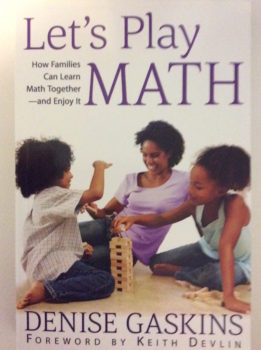Let’s Play Math: review of a book to make math fun

By Kathy Kuhl Review of Let’s Play Math: How Families Can Learn Math Together—and Enjoy It by Denise Gaskins. 290 pages. Tabletop Academy Press.
What if we’ve been teaching mathematics the wrong way?
Denise Gaskins’ new book, Let’s Play Math, is revolutionizing how I think about the subject. She is a veteran homeschool mom who enjoys mathematics and has a knack for sharing that joy. She is a veteran teacher and tutor, from pre-K to undergraduate level.

Think differently about mathematics instruction
Here’s an analogy. Suppose you wanted your children to study baseball. You taught them to throw and hit, and in high school, you taught them the rules of the game and strategy, like when to bunt or steal a base. But imagine they never played or watched a game. How would they feel about their baseball homework?
“Aw, Mom! Do I have to practice pitching? When am I ever gonna need this?”
Denise says that’s what’s happened to mathematics instruction. The essential play has been left out. I say essential, because for mathematicians, mathematics is a playful, creative activity.
Her second point is that we think of this subject too narrowly: “Math is like ice cream, with more flavors than you can imagine. And if all you ever do is textbook math, that’s like eating broccoli-flavored ice cream.” (From the introduction)
In chapter one, she explains:
Here is the secret solution to the crisis of mathematics education: we adults need to learn how to think like mathematicians.
- Mathematicians avoid busywork as if it were an infectious disease.
- Mathematicians always ask questions.
- Most of all, mathematicians love to play.
As we cultivate these characteristics, we will help our children to recognize and learn true mathematics.
How to enjoy math
We may be tempted to think of mathematics instruction as one more box to check off, or at best a set of knowledge and skills for our kids to learn.
But occasionally, we and our children glimpse a little fun or beauty in mathematics. How do we nurture that vision? Denise offers hundreds of resources and ideas for how to enjoy the subject; so many suggestions you could spend years exploring them with your children. But don’t be overwhelmed: give it a try.
But wait, beauty in mathematics? The author explains:
“Patterns are so important that American mathematician Lynn Arthur Steen defined mathematics as the science of patterns. “As biology is the science of life and physics the science of energy and matter, so mathematics is the science of patterns,” Steen wrote. “We live in an environment steeped in patterns — patterns of numbers and space, of science and art, of computation and imagination. Patterns permeate the learning of mathematics, beginning when children learn the rhythm of counting and continuing through times tables all the way to fractals and binomial coefficients.” (Location 705-709)
But I hate mathematics, so how can I help my kids like it?
Denise Gaskins understands this. She’s no geek who can’t imagine our fears. She gives practical help and encouragement:
- “If you’re afraid of math, be careful to never let a discouraging word pass your lips. Call upon your acting skills to pretend that math is the most exciting topic in the world.” (Location 696)
- “…the more we adults tell about a topic, the less our children learn. With the best of intentions we provide information, but we unwittingly kill their curiosity. (Location 700-701)
- Quoting W.W. Sawyer: “Most remarks made by children consist of correct ideas very badly expressed. A good teacher will be wary of saying ‘No, that’s wrong.’ Rather, he will try to discover the correct idea behind the inadequate expression. This is one of the most important principles in the whole of the art of teaching.” (Location 762)
The book includes:
Here’s the table of contents for Let’s Play Math, a book you can be dipping into and learning from for years:
Section I: How to Understand Math
Introduction: Can You Identify the Math Myths?
Chapter 1: The “Aha!” Factor
Chapter 2: Think Like a Mathematician
Section II: Playful Problem-Solving
Chapter 3: Math You Can Play
Chapter 4: Math You Can Touch
Chapter 5: Math That Makes You Think
Section III: Math with Living Books
Chapter 6: Math You Can Read
Chapter 7: 4,000 Years of Stumpers
Section IV: Let’s Get Practical
Chapter 8: Weaving It All Together
Chapter 9: Struggling with Math
Chapter 10: Transition to High School Math
Conclusion: Growing Up with Math
Recommendation
I recommend Let’s Play Math by Denise Gaskins. Click here to buy it on Amazon.
To sample more of her writing, see her blog at DeniseGaskins.com
What do you do to help your children and teens enjoy mathematics? Please comment below.

